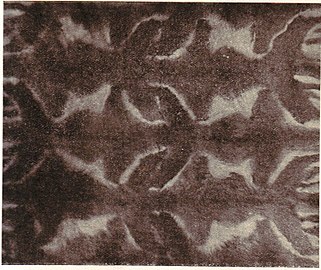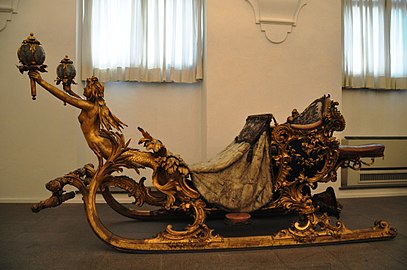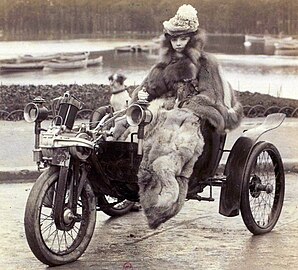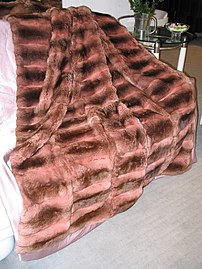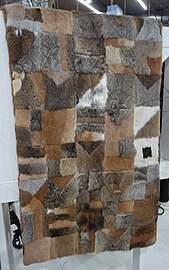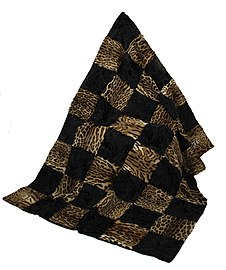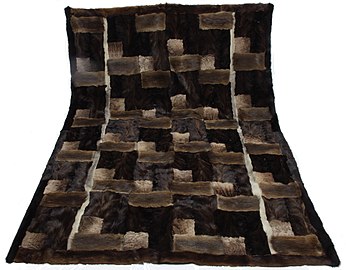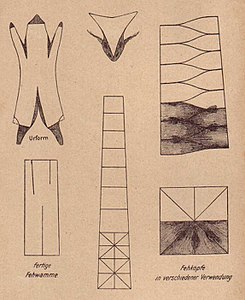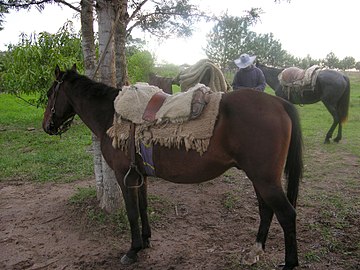Fur blanket
A fur blanket , also known as a fur blanket , fur plaid or similar, is a protection against the cold made from furs , usually lined with fabric, which is mainly used today as a home accessory . In the past, fur blankets were also used as blankets for wagons and sleds, and later as car covers. Smaller, possibly artistically designed designs are also used as rugs or wall decorations.
General
Today, a fur blanket is usually understood to be a blanket made up of several, mostly smaller skins, such as fox skins or possum skins . At least historically, rugs that are made in their natural form from a single large animal, such as angora goats or reindeer, and formerly mainly bears and big cats, were also referred to as fur blankets.
Blankets made of longer-haired fur are particularly popular. They are often used not only as a cover, but also as a seat pad on sofas and the like. In addition to leather that is as tear-resistant as possible, good abrasion resistance of the hair is important here. Of the most common types of fur, particularly in descending order: sheepskin and guanaco fur (restricted trade permit), with some distance raccoon fur , possum fur, fox fur, unsheared rabbit fur , coyote fur and the wolf fur that is no longer used today . The shorter-haired types of fur include lambskin , mink fur and all types of marten, such as the absolute luxury furs, pine marten fur and sable fur . At least in the 1930s, people still had an idea of which types of sheepskin were particularly suitable as blanket skins, among others the heavy Transylvanians, Turks, Moldovans and Macedonians named after their origin. A textbook from the 1950s, cites as suitable for Divan- and car ceiling hides also the skin of the guanaco related vicunas and the Skunk fur , both very durable, and the jackal fur and now occupied by a trade ban cat fur .
The rabbit fur, which is also widely used, is special in terms of its durability. Wild rabbit fur , similar to rabbit fur , tends to shed. Skins of good quality from domestic rabbits are much more durable with their thick hair, and due to the closed hair cover, they even have an almost very good durability.
history
Primitive peoples
Most peoples seem to have developed the fur garment from simply wrapped fur to a blanket-like cape, which was also used as a bed. This resulted in slit throws in the style of a poncho , which the Germanic ponchos also wore.
The body is a blanket-like fur cloak of some tribes in southern Africa. The fur garment was also used as a bed pad and blanket.
Washoe Indian women making a woven rabbit blanket (around 1935)
Mary Lowe with a woven blanket "made of 100 rabbit skins" ( Paiute ethnic group , USA 1937)
The North American Indians made blankets from buffalo hide, which they used as storage blankets and cloaks. A hallmark of the members of various tribes was the blanket-like chief's coat made of buffalo skin. The deeds of the chiefs were painted in animated pictures on the leather side of the coats or blankets.
A special kind of fur blanket is woven from fur cut into narrow strips, a technique of fur processing that was once widespread among the Indians from Mexico to northern Canada. The North American Anasazi twisted or twisted cords made from the fur of prairie dogs, bears, beavers, rats, mice, rabbits and mountain sheep, to use them as twine, but also to weave blankets from them. In the winter of 1957/58 McIvor documented the fur-weaving of the North American Indians using the example of the Cree in Fort Hope in northern Ontario . At that time, the local residents only made coats and jackets for small children. Originally, cloths and blankets were woven in which men and women would also wrap themselves. The material used was usually rabbit skin, in this example the skins of the snowshoe hares, the meat of which was previously the main source of food in the area. Nothing is reported about any special processing of the leather side. The peeled-off fur is cut into strips about the width of a thumb, in a spiral shape in a single, long piece. The strip width varies depending on what is to be made from it. The strips of fur are wrapped with the hair facing outwards on a thin rod about one and a half centimeters in diameter and dried in this way. The further processing varies according to the landscape, the Cree weave the stripes into nets, just as it happens in the "newly developed" web-netting fur processing. The spiral shape ensures that the strips wrap around the net threads with the hair facing outwards, creating a hairy surface on both sides. The nets are now made from string, in the past from sinews or leather straps ( babiche ). The finished ceiling was hung in a specially made frame and stretched on three sides. For a smaller blanket, 85 heads were used. Blankets in particularly cold areas were woven more densely and accordingly required more skins. The result is very warm and yet light, very stable and hardly ruffles. Older people wore the faux fur for three or four years, children got a new piece every year. Sometimes the fur was sewn concealed between two lengths of fabric, in the manner of a quilt, which not only improved the warmth but also the durability. The hair of the rabbit is not very durable and the furs showed bald spots very quickly. This technique was rediscovered in a more refined way towards the end of the 20th century. Since then, considerable quantities of furs braided and woven from three to four millimeter wide strips of fur have been coming into world trade from Asia, mostly as small items such as scarves, vests and ponchos, and rarely blankets.
The hard-wearing blankets made from the fur of the South American guanaco with their attractive pattern are appreciated. In addition to the single-skin hunting trophies, it is the only type of fur that is mainly used for blankets. However, the guanaco is listed in Appendix II of the Washington Convention on Endangered Species, the fur may only be traded with an export permit from the country of origin. Even the indigenous people of the Andean region appreciated the fur blankets called Quillango. They had developed the assembly of the skins into an art, with the shape difficult to work with due to the long leg sections. The Tehuelche in particular also dressed in the blanket cloaks, they were part of the national clothing. The leather side was richly decorated with figures by the Tehuelch women. During the 19th century, guanaco blankets and coats became their most important commercial item, exports peaked around 1870 and then collapsed.
Jaguar skin blanket, reverse side painted with red patterns, Bororo ethnic group (Mato Grosso, Brazil)
Assiniboine Indians with a buffalo blanket (1908)
Antiquity to the 19th century
In Exodus, the second book of Moses , a blanket was stretched over the tabernacle - the sanctuary that Israel received on Sinai for the time of the desert wandering - according to the descriptions. It consisted of ram skins dyed red and was covered by another tarpaulin made of tahash skins or skins. With Tahash, the Hebrew word תַּחַשׁ taḥaš is taken over, the meaning of which is unclear (Luther Bible: " badger skins "; Jerusalem Bible: "fine leather").
Fur blankets were used by the Romans and the Greeks. When they were led home, fur blankets were placed under the brides. The Greek Diodor (1st half of the 1st century BC) mentions dog and wolf skins that were used by the Celts for carpets or blankets. The Roman Pliny the Elder (23/24? -79), in whose home duvets made of fur were more common, mentions a blanket or carpet made of mole fur that he saw on one of his trips to Greece. On an official Roman price list from 301 the maximum price for a blanket made of eight goat skins with 333 silver denarius is set.
In the song of the Nibelungs it is reported that the Burgundian kings, when they came to their beds as guests of the Hun king Etzel, stated:
- The bed covers looked like they were made of ermine
- And also of black sable, including the night
- You should rest leisurely until the light of day:
- A king has never been so wonderful with friends ...
In the inventory list of the Venetian noblewoman Maria, relicta quodam Clarissimi Domini Hieronimie Pollani, died on January 7th, 1590, there are over sixty fur-lined robes and a large number of fur-lined bed covers. There were also different types of rugs, which were prepared with heads and tails, "as if they were alive": a lion skin with glass eyes, a tiger skin with a stuffed head, a prepared monkey and a large box with moth-eaten carpets or blankets.
In ancient Russia there was only straw or hay in the rental sledge to keep your feet warm. In the rulers' sleigh, on the other hand, there was a footmuff made of fur, over the knees was a large blanket, lined with fox or other soft fur on the underside and trimmed with another, valuable fur on the top. When the peasants drove across the country, they put as much skins as they could find in the sleigh. A footmuff and a warm blanket were not enough for the landowner: “He sits in large, foot-length fur in his light wicker sledge, which - depending on the circumstances - is entirely covered with a large blanket made of fox or polar bear fur. As soon as he is seated, this blanket is buttoned in various places so that he is wrapped in a warm sack. "
"A princely bed". Underside of the duvet made of dewlap (approx. 1165)
Queen Sophie Charlotte of Hanover . Ermine blanket as a nobility insignia (1705)
Industrial revolution until today
The general mechanization of handicrafts also gave skinning a tremendous boost. With the invention of the fur sewing machine towards the end of the 19th century, furs could be produced with a considerably lower share of labor costs. For the production of fur blankets, however, this was not of as significant importance as it was for the manufacture of fur clothing, in which complex working techniques were now used that were previously hardly conceivable for reasons of cost.
In 1895 it is mentioned that eight to ten fox skins were usually used for a wagon cover. About thirty years later, fur blankets were rarely required, and trains and automobiles were gradually heated. For example , the dimensions of such a blanket made of natural cat skins were assumed to be 160 × 200 centimeters. If it got a quilted edge, "the quilted edge of the cloth looks really nice", they estimated forty skins for the blanket. Each fur should be about four inches long and eight inches wide, ten pelts for the width and four for the length.
As late as 1950, so-called dogmats, dogrugs and dogrubes, tablets made of dog fur , were trade items coming from China. Dogmats were about 50 × 100 centimeters, dogrugs made of two Manchurian dog skins measured 40 × 160 centimeters and dogrubes made of four Manchurian skins 70 × 170 centimeters. These panels, known in English as blankets or carpets, were only used as such in a small part; they were used as semi-finished fur products for further processing, after the advent of motor vehicles, for example, as motorists' coats for men.
Around 1900 , fur blankets , then known as “ mosaic work ”, were particularly relevant. However, they were used less as blankets than as small carpets (rugs). In addition to the frequent rugs made of naturalized furs, some with elaborated heads, they were occasionally found in living rooms and salons. In Vienna, some artistically gifted furriers had achieved a special mastery in the design of fur images, such as large double-headed eagles, addresses of homage and flags of a sea battle. A Viennese colleague wrote, in keeping with contemporary tastes: “Usually the furrier has beautiful dogs to work on blankets, which should always remind the owner of the animal that has died. Even deer and deer are working to rugs. The fur rug is either created with a naturalized head, as is the case with dogs, foxes, bears, leopards and other animals, or the head is cut away just behind the ears and rounded off, as with deer and roe rugs. "
A pavilion made by Revillon Frères , which had set up a small medieval shop in the Palais de Costume, attracted particular attention at the Paris World Exhibition in 1900 . The side walls were covered with two large carpets: "One of these carpets, which fundamentally Sealbisam was was with large and small naturalized Cravaten from all kinds of fox, marten , sable , ermine , chinchilla , sheds , etc, richly decorated, while the other carried the main tools of the furrier: knife , pliers , comb and knocking stick made of fur. This second carpet by a transverse strip of Fehwammen was separated into two parts had when Decoration also still a collar and muff of ermine, fur gloves of otters , fur hat , a naturalized Rothfuchs and arabesques of blue colored Carakul ". - Revillon Frères had covered the floor of their pavilion with a blanket of 22,000 mink tails galonized with the finest leather, sewn with the fur sewing machine invented a few years earlier , "the beautiful and precise work aroused everyone's admiration".
In a study of skinning in Frankenberg in Saxony from 1895, foot rugs and bed mats made of lambskin are mentioned, which were still made in the same quantity by the furriers there, while the demand for footmuffs had decreased significantly. For the blankets, the less strong lambskins were used, which the furriers themselves bought from producers, in contrast to most other types of fur obtained from fur wholesalers .
The master furrier August Dietsch, born in 1901, recalled in an article in the GDR magazine Brühl :
“ We have fed Australian opossums , sea foxes , raccoons and black sheepskins, road, travel and riding fur with lighter types of fur. Car covers were also a very popular item for open wagons among the wealthy. Fox, raccoon, wolf and dog were used as material. Most of the wealthy bourgeoisie and great agrarians bought wagon covers made of lighter materials, such as guanaco (Lama guanicoe Müller), vicunā (Lama vicugna Molina) and alpaca (Lama guanicoe pacos Linné). I remember that customers from high finance and the nobility even bought car covers made of blue fox and American sable. Their coachmen equipped them with heavy furs - made of simple skins, of course - which were usually completed with a cap and cap made of black American baribal. "
It was reported that the albatrosses accompanying the ships in the southern seas were often caught by the sailors to make warm blankets out of the skins. Until about the end of the first third of the 20th century, haberdashery and smaller furs made from different types of bird skins were still in vogue. At the time, very attractive blankets, including eider duck and cormorant fur, were also made.
In October 1996, fashion king Karl Lagerfeld told Stern magazine: In summer I sleep under a white ermine blanket, in winter under sable.
In Germany, the hunting association is promoting the use of the red fox pelts, and an annual model competition has been held since 2011 with the help of sponsors. However, the current price of fur is not a great incentive for felling, but a considerable number of hunters have blankets made from their fur. As of 2018
Eider , neck and neck fur (1918)
Pahmi (around 1990)
Wieselfell , Pine-Weasel (2010)
Chekiang Lamb (2011)
Chinchilla (2009)
processing
For the wagon blanket made of natural cat fur from 1928, mentioned as an example, the following work instructions were given: “We cut the cats to the same size and then put them together, making sure that the groats converge well and that an even stripe effect is achieved. Then purposes we rub after drying the skins soft and quilt. We then attach the cloth and sew it all around. If it is about skins that are processed with tails around the blanket, as was the case with foxes, then it is better to warp than sew . While with a cat blanket the skins can all run in one direction, with fox blankets the skins will run apart from the middle in order to achieve the tail effect on both sides ”.
The Hofstetter company in Rötz was probably the first to develop attractive, material-saving processing for European red foxes. As usual, the skins are placed side by side in two rows, about seven to eight pieces each. The narrow head parts are supplemented with the otherwise sloping paws to the body width of the fur. The two strips are sewn together with the heads parting in the hair. The result is a very appealing image and the Plaid wins by elongating the heads in addition to width without the skins left out to be (standard dimensions: 140 x 200 and 130 x 180 centimeters).
As a rule, a fur blanket is made from one and the same type of fur. In addition, ceilings with ornaments or picture motifs are made, which are made from differently colored skins of the same type of fur or from different types of fur. When redesigning worn furs, jackets and coats into blankets, several types of fur are often combined into one blanket.
In times when fur blankets were of great importance as thermal protection, only the better blankets were lined with cloth. Strong, rustic fabrics such as jute, burlap or felt were used for the simpler qualities. Felt was and is still a popular material for individual skins left in their natural shape, as it can be processed with open edges without fraying. The edge of the felt protruding beyond the fur is often edged with serrated shears. Warming inserts such as cotton wool or cotton wool served as intermediate lining. A pricking the leather side with a linen cohesive material (Pikierstoff, Batist ) increases the tear strength of the ceiling.
We are also happy to work on a decorative fabric edge that enlarges the ceiling, possibly with stitching. This is already mentioned in a specialist book in 1891. A special feature there is that you do not hold the lining with stop seams before it slips against the fur: "So that the lining has a good hold, you make buttons of the lining cloth with wooden insert, which you sew on at regular intervals to connect to the blanket" .
Made from Indian lamb jacket , muskrat back , mink paws and various mink ties (2020)
- Fur blanket processing in 1895
Muskrat heads , example of putting together muskrat head pieces
right example of Fehfell -Resteverwertung
Example of the assembly of galoned sable tails
Fur saddlecloths
Saddlecloths protect both the horse and the saddle. Natural fur is often used for the blankets attached under the saddle, usually sheep, which absorbs sweat and protects the horse's skin well from chafing. The same effect, only protecting the rider, have lambskins attached to the saddle. Larger, decorative saddlecloths are still often used for festive appearances and trail riding .
The older military equipment of the cavalry also included expansive saddlecloths, often made of fur. Most of them were sheepskins, but bearskins weren't too rare either. For representative occasions, some regiments even had saddlecloths made of leopard skin or tiger skin with a fabric underlay .
Karl V. Leopold , on horseback with a fur saddlecloth (1686)
Black-footed Indian with puma skin saddlecloth (1840)
Typical "sandwich" saddling of the Criollo horses of the gauchos , layered, among other things, made of one or more lambskins (Paraguay, 2005)
facts and figures
- January 29, 1855 : "Public auction of chaises, sledges and harnesses by Georg Hollenbach senior in Ansbach". Among other things, seven sleighs with one or two horses were put up for auction, three with fur blankets (one with one, one with a beautiful and one sleigh with two fur blankets).
- Around 1900 : The Pelzwaaren Friedrich Erler company offered in their catalog:
- Travel blankets:
- Carpets of all kinds, with and without naturalized heads, from the smallest to the most valuable.
- Car and sledge covers are made to measure as quickly as possible.
- 1907 was Otto Buchheim from Langensalza in its catalog:
- Chinese goat rugs, just great skins. Size approx. 80/170 nat. gray, M. 12.-
- in all other colors, as wolf, bear etc., 13.50
- Angora blankets in all colors and Sizes, size approx. 48/85, M. 10.-
- Shetland sheep blankets in all colors, very nice looking, size 75/165, M 10.- , are available in every size.
- Desk rugs with foot pockets in a large selection and at various prices.
- In 1908 , Chr. Heuer, fur manufacture in Leipzig offered:
- Sledge and carriage covers.
- Sheepskin, lined with black, with and without trimmings, sizes 50 to 75 .
- In 1953 , in a price list of the GDR, the remuneration of the furriers for the production of fur blankets was specified for two types of fur:
- Guanaco blankets, 2.40 m per fur
- Sheepskin lining and lambskin lining 7.85 M.
- Sheepskin blankets like guanaco worked per hide 1, - M.
Web links
Individual evidence
- ↑ a b Alexander Tuma: Pelz-Lexikon. Fur and Rough Goods, Volume XVIII . Alexander Tuma, Vienna 1949, p. 129 (keyword "fur blanket").
- ^ Fritz Hempe: Handbook for furriers . Verlag Kürschner-Zeitung Alexander Duncker, Leipzig 1932, p. 113. → Table of contents .
- ^ Ernst Kreft: Modern working methods in the furrier trade, 2nd improved edition. Fachverlag Schiele & Schön, Berlin undated (the 1st edition appeared in 1950), p. 70.
- ↑ Bruno Schier: Furs from an ancient perspective . Publishing house Dr. Paul Schöps, Frankfurt am Main 1951, pp. 30–34.
- ↑ Werner-Wolf Turski: The Pueblo Cultures - Anasazi, Fremont . Volume 4. Last accessed March 28, 2018.
- ↑ Unspecified by author (to photos by AB McIvor): Rabbit Skin Robe In: The Beaver , Winter 1958, Hudson's Bay Company, pp. 46–47.
- ↑ www.bibelwissenschaft.de, Petra Watermann: Fell / Pelz . According to Ex 26,14; Ex 36.19; Ex 39.34 (see Ex 25.5; Ex 35.7.23).
- ↑ D. Christ. Wilh. Jakob Gatterer: Treatise on the fur trade, in particular the British . Schwan and Götz, Mannheim 1794, p. 75. Primary source: Plutarch problem. 29
- ^ Francis Weiss : From Adam to Madam . From the original manuscript part 1 (of 2), (approx. 1980 / 1990s), in the manuscript p. 39. (English: "rugs").
- ↑ Francis White : From Adam to Madam I . Undated original manuscript, pp. 41, 43, 46.
- ↑ Alexander Tuma: The history of the skinning . Verlag Alexander Tuma, Vienna 1967, p. 79.
- ^ Richard Davey: Furs and Fur Garments . The International Fur Store and The Roxburghe Press , London 1895 ?, pp. 26-27 (English). Last accessed August 4, 2018.
- ↑ A. Popenzewa: fur in old Russia - furs for sleigh rides . In: Der Rauchwarenmarkt , July 10, 1936, p. 3.
- ↑ Heinrich Hanicke: Handbook for furrier . Published by Alexander Duncker , Leipzig 1895, p. 36.
- ↑ a b c Alexander Tuma jun .: The furrier's practice . Julius Springer, Vienna 1928, p. 218-220 . → Table of contents .
- ↑ Alexander Tuma: Pelz-Lexikon. Fur and Rough Goods, Volume XVII . Alexander Tuma, Vienna 1949, p. 33 (keywords “ceiling”, “dogmat”, “dogrobes”, “dogrugs”).
- ↑ Paul Larisch , Josef Schmid: The furrier craft . 1st year, No. 1 + 2, self-published, Paris, October-November 1902, pp. 5–6, 31.
- ^ Albin König: The furrier in Frankenberg in Saxony . In: Studies on the situation of the craft in Germany with special consideration of its competitiveness compared to large-scale industry . Volume 2, Kingdom of Saxony , first part, Duncker & Humblot, Leipzig 1895, p. 325.
- ↑ A master furrier from Brühl remembers. In conversation with August Dietzsch . In: Brühl , November / December 1986 edition, Fachbuchverlag Leipzig, p. 29.
- ↑ Fritz Schmidt : The book of the fur animals and fur . FC Mayer Verlag, Munich 1970, pp. 388-391.
- ^ JL Perrier: Traité pratique du fourreur Français . 3rd edition, Paris 1924, p. 132 (French).
- ↑ If the author is not stated: Jäger Behind Bars In: Der Spiegel , February 2, 1996. Last accessed April 2, 2018. Primary source Zeitschrift Stern .
- ↑ Wild und Hund Redfox Award . Wild and Dog magazine . Last accessed April 3, 2018.
- ↑ Without information about the author: Ingredients for fur processing. Fur blankets, templates and foot pockets . In: The Kürschnerfibel . Supplement to the Kürschner-Zeitung , No. 4 , April 21, 1938, pp. 41-42 .
- ↑ Paul Cubaeus: The whole of Skinning. Thorough textbook with everything you need to know about merchandise, finishing, dyeing and processing of fur skins . 1st edition. A. Hartleben's, Vienna, Pest, Leipzig 1891, p. 399 .
- ↑ Eva Nienholdt: Fur in the war costume and uniform . In: Das Pelzgewerbe No. 6. 1958, Hermelin-Verlag Dr. Paul Schöps, Berlin et al., P. 276.
- ↑ Special supplement to the Ansbacher Morgenblatt Nro. 19 BC January 24, 1855 , Carl Brügel, Ansbach. Last accessed April 5, 2018.
- ↑ Catalog Friedrich Erler, p. 15.
- ↑ Catalog Chr. Heuer, p. 59.
- ↑ Price regulations for the furrier trade of July 17, 1953 (GDR) , p. 8.
- ↑ Price regulations for the furrier trade of July 17, 1953 (GDR), p. 10.






